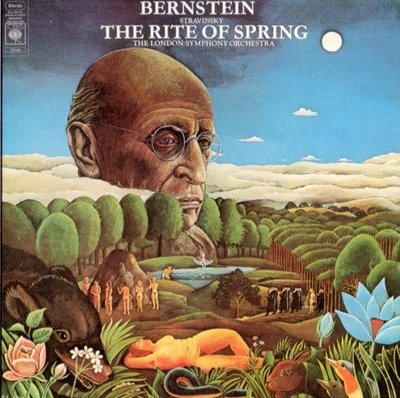Frances & I did one of our Philadelphia get-aways this weekend. We planned it around the Philadelphia Orchestra‘s performance of Stravinsky’s The rite of spring. Somehow Frances has managed to never hear it live, but I vividly remember the first time I heard it in concert. I was about 17 at the time, and would usher at Atlanta Symphony concerts regularly. The night that they did The rite of spring, it was a revelation to me. I sat on the edge of my seat the entire time, leaning in, completely absorbed. At the time I was keen on playing things like Prokofiev sonatas, but this was music that came from a different place altogether. The rhythmic and instrumental power of the piece amazed me, and I couldn’t believe each turn of events, whether they were subtle rhythmic patterns or violent eruptions of percussion. I bought a record of the piece and listened to it endlessly at home, full-blast on the stereo (the photo above is the cover art from that album).
So part of going to hear it again was a trip down memory lane and a chance to maybe recreate a bit of that youthful excitement. Of course I’ve heard and studied the piece over the years, both as student and professor. I remember being struck by its lyrical side when I delved into it in grad school after leaving it alone for several years. It perhaps became a bit tamer for me. So in going to Philadelphia, I wanted to touch again that experience of awe and rapt attention in front of this remarkably powerful music. I wanted it to grab my attention again.
You can imagine that I was apprehensive and disappointed as I sat down in my seat and read that the performance was a collaboration with Ridge Theater Company, in which the original scenario would be reimagined via video projections, a trapeze artist, and a dance featuring women in brightly-colored gowns. I had come to worship the Rite, and found a circus (literally) in the temple. I tried to shrug it off, pointing out to Frances that we could always just close our eyes and pretend it wasn’t there, but I was hurt by the desecration not so much of the music, but of my cherished memory.
What really upset me the most was feeling so out of place in what used to be my home. My dream of single-minded attention on an incredibly compelling musical monument is so hopelessly outdated today, so completely devalued. Frances and I discussed it afterwards and admitted as how the Stravinsky was hardly pure music: it was meant for the theatre. But it has always had a home in the concert hall as well, and its power is perhaps too much for any merely human stagecraft. In any event, the orchestra’s decision to add theatre to the concert performance was obviously not a result of someone’s deep engagement with the Rite as a theatrical whole. The program described this as an attempt “to extend the boundaries of the symphonic experience in today’s hyper-visual world.” It was pitifully tacked-on, a misguided attempt to make the Rite more interesting to a concert audience. I am well aware that this is the sad trend in concert music everywhere today, but had no idea it had gotten this bad. When orchestras think that they have to do something “extra” to make The rite of spring interesting, we are in deep trouble culturally.
The music blog On an overgrown path has done a great job of covering the well-meant undermining of classical music by orchestra, record label, and radio management. In one particularly good post, he points out that the need for change like this is mindlessly parroted everywhere, but that there is absolutely no market data to support any of the “dumbing down” exercises that are engaged in. And there is the risk of losing the core audience altogether. I mention this because, after our experience with The rite of spring, Frances & I are thinking twice about future excursions to the Philadelphia Orchestra.

